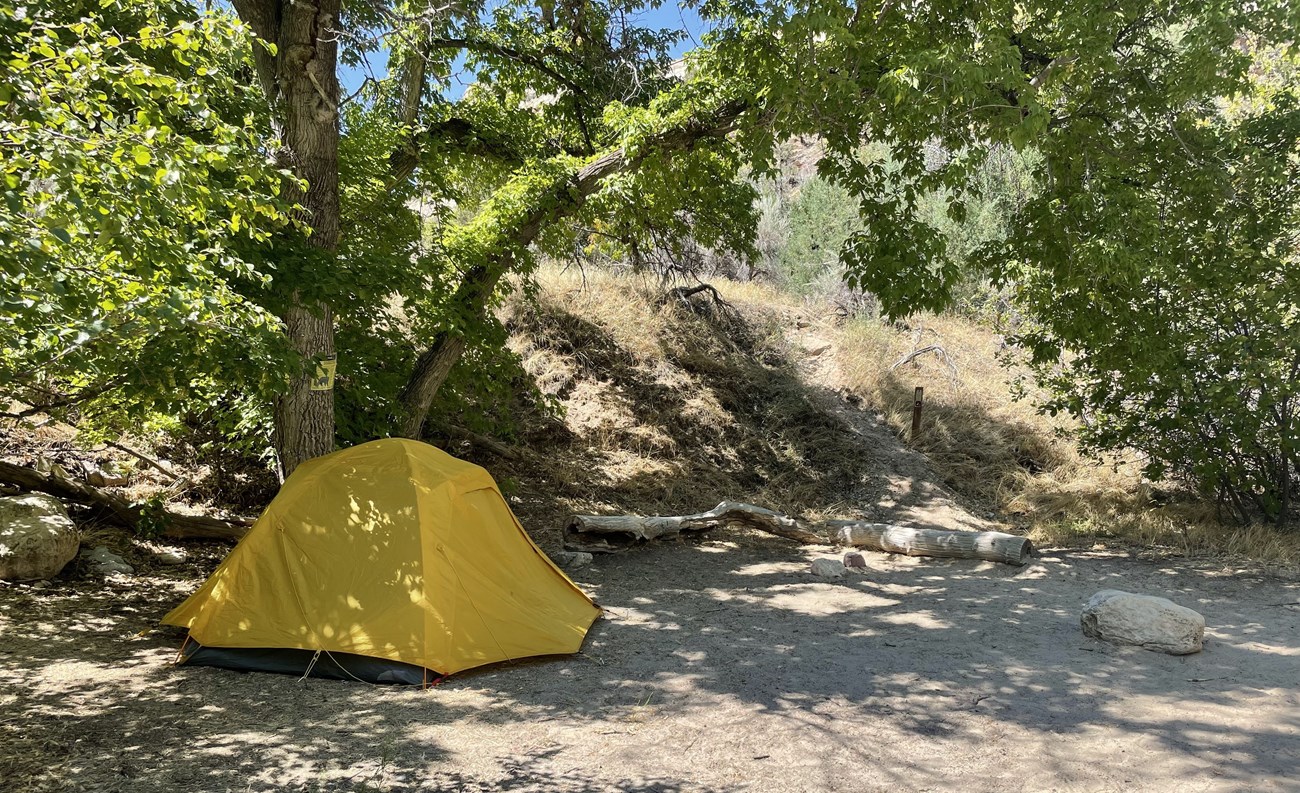
NPS / Molly Swindle Free backcountry permits are required for overnight stays outside of established frontcountry campgrounds. For experienced backpackers, there are many opportunities for backcountry camping. The beauty and solitude are inspiring, but the terrain is isolated and rugged. It is also very difficult to find water in the backcountry. Good planning is essential. Please remember that despite its appearances, Dinosaur National Monument is home for black bears. Proper storage of food or any items that produce odors is required at all locations in the backcountry. Visit our bear information page for details.
Designated Backcountry CampsitesEly CreekThe only designated backcountry campsite for hikers within the monument is located at the confluence of Jones Hole Creek and Ely Creek, along the Jones Hole Trail. There is one campsite here. Reservations are required for this popular location. Special considerations:
River Sites (Low-use river season only)Additional designated backcountry campsites for boaters are located along the Green and Yampa Rivers. During the high-use river-running season, these sites are only available to boaters. Backpackers may use the river campsites on a first-come, first-served basis only during the low-use river-running season and only with a backcountry camping permit. Boating groups have priority over hikers for designated river campsites even with a backcountry camping permit. Dispersed Backcountry CampingBackcountry campers are responsible for knowing and following all monument regulations, including how to select appropriate camping locations that align with Leave No Trace principles. Most of Dinosaur’s 211,000 acres are open for dispersed backcountry camping with a backpacking permit. It is the responsibility of the permit holder to select a route and campsite locations that fit their groups' abilities. Camping next to or inside of vehicles along roads or at overlooks is not allowed.
Backcountry camping is PROHIBITED:
Backcountry Regulations and Safety Tips1. Be Bear Aware - Keep a Clean CampDinosaur’s backcountry is home to black bears and other animals that may be attracted to the smell of food and trash. Keep all scented items together, away from your sleeping area. Use animal resistant metal or plastic containers or hang items at least 10 feet above the ground and 4 feet out from a post, tree trunk, or other object; small animals are often a greater concern than bears for getting into food or trash. Pack out all leftover food and trash, do not bury them. At Ely Creek, use the provided food locker.
2. Fires and Firewood CollectionPortable gas stoves are recommended for backcountry use. Fires are PROHIBITED in the backcountry with the following exception: open wood and charcoal fires are only allowed on elevated fire pans with fire blankets in designated river campsites. Do not collect woody debris from within the monument, even dead and down, except boaters may use of driftwood found along the Yampa River or downstream of the Yampa-Green confluence. 3. Pets & BicyclesPets and bicycles may only go where cars go, which is along roadways or in frontcountry campgrounds. Neither are allowed in the backcountry. See additional pet regulations for pet-friendly frontcountry trails. Trained Service Animals are allowed anywhere their person goes. 4. Leave No Trace
5. Be Ready for AdventureDinosaur’s rugged, open landscape offers many off-trail challenges for backcountry hikers. Hikers must be comfortable with map reading and route finding. 6. Bring Adequate Drinking WaterWater is scarce in Dinosaur’s backcountry. Most routes require water to be packed in. Water from streams, springs, and ponds must be treated. Drinking from the Yampa and Green rivers is not advised, even after treatment. Carry and drink at least 1 gallon of water per person per day. Eat salty snacks as well as regular meals. As you exercise, you lose salt and water. You need both to survive. Consider the climate, weather forecast, the length and difficulty of your hike, the high elevation (5000’ to over 8000’), and your physical condition as you plan your trip. You may need to carry more water and travel fewer miles in Dinosaur than in other locations you’ve visited. 7. Know Backcountry Road ConditionsSome backcountry roads are infrequently traveled and may be in poor condition. Make sure your vehicle and tires (including a spare) are in good working order. Unpaved roads become hazardous when wet because of gooey clay, steep grades, and drop-offs. 8. Be Alert for WildlifeAnimals are a natural part of the environment; be prepared for the possibility of an encounter and enjoy their presence from a safe distance. Place your hands and feet carefully to avoid snakes; be prepared to cope with insect bites and stings. Report mountain lion or bear sightings to a ranger. Cattle are also unpredictable and potentially dangerous. 9. Wildfires Are A Risk When It Is DryKeep an eye on the skies and have an escape plan. Rangers may try to contact you using the phone number given for the permit. 10. Canyons Can Be DangerousCanyons can become steep and impassible without ropes. Technical rock climbing is subject to additional equipment and regulations. Any equipment or activity that damages vegetation or rock surfaces is not allowed. 11. Swimming Is Not RecommendedSudden drop-offs and unpredictable currents make the Green and Yampa rivers potentially hazardous. Do not attempt to cross the Green or Yampa river without wearing a PFD. 12. Communication Devices May Be UnreliableMobile phones do not work in many places in the backcountry. Make alternative plans to communicate with family and friends before and after your trip. |
Last updated: June 25, 2025
